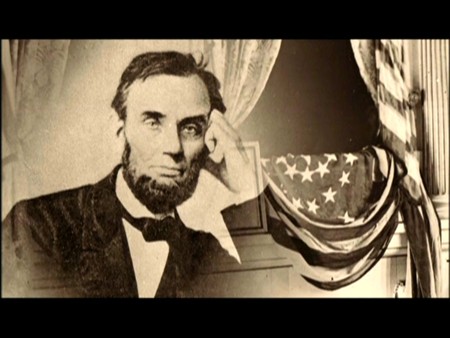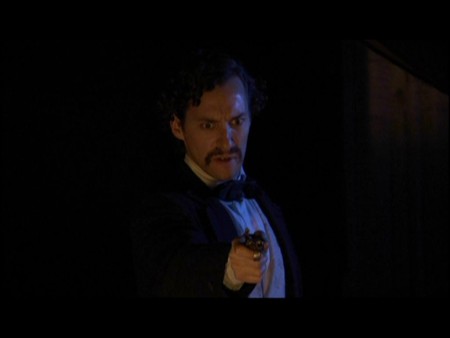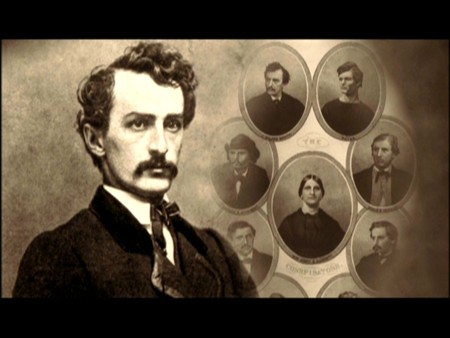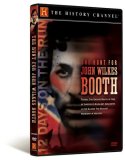| Reviews & Columns |
|
Reviews DVD TV on DVD Blu-ray 4K UHD International DVDs In Theaters Reviews by Studio Video Games Features Collector Series DVDs Easter Egg Database Interviews DVD Talk Radio Feature Articles Columns Anime Talk DVD Savant Horror DVDs The M.O.D. Squad Art House HD Talk Silent DVD
|
DVD Talk Forum |
|
|
| Resources |
|
DVD Price Search Customer Service #'s RCE Info Links |
|
Columns
|
|
|
Hunt for John Wilkes Booth, The
About halfway through The Hunt for John Wilkes Booth (based on the book, American Brutus: John Wilkes Booth and the Lincoln Conspiracies by Michael Kauffman, who also appears here on the documentary), historian Roger McGrath states that most Americans, in regards to the assassination of President Abraham Lincoln, know only that John Wilkes Booth shot Lincoln at the Ford Theatre in Washington, D.C., while knowing little or nothing of the events leading up to and following this terrible act. He may be right. As a little kid, I remember seeing that Sunn Classic Pictures shlock-tacular, The Lincoln Conspiracy (the one where Bradford Dillman's fake moustache is always in danger of falling off), as well as some other documentaries on the subject since then, but prior to watching The History Channel's The Hunt for John Wilkes Booth I doubt I could have named all his co-conspirators, nor say with certainty if Booth was captured and tried, or killed during the manhunt for the famous actor and notorious assassin.

Fortunately, The Hunt for John Wilkes Booth is a clean, straightforward, lucid treatment of the assassination, and a good refresher course for students or anyone else interested in filling in the gaps on this seminal moment in American history. Presented in a thoroughly typical History Channel documentary style (filmed re-creations of selected events, animated maps, liberal use of vintage photos and engravings, plus talking heads interviews from historians and authors), The Hunt for John Wilkes Booth may not be the most scintillating documentary you'll see this year, nor is it a Master's course in the subject (I would imagine there will be historians and assassination buffs out there who will debate its conclusions on many tangents of the story), but it's an excellent grounding for an historical event we should all understand more thoroughly.
As you may remember from your school days, Abraham Lincoln, celebrating the end of the Civil War less than a week before, attended a performance of Our American Cousin at Ford's Theatre in Washington, D.C. on April 14, 1865, when he was shot in the back of the head by John Wilkes Booth, who was a renowned stage actor and known Confederate sympathizer. Lincoln, mortally wounded, was moved across the street from the Ford to the Petersen rooming house, where he lay in a coma until he expired the next day.
Now I would imagine most people are pretty comfortable recounting that main thrust of the story of Lincoln's assassination, but discussions of Booth's prior kidnapping plots, or his plans for simultaneous assassination attempts on other government officials, or details of the chaotic twelve day manhunt for Booth, or even his final ignominous end - shot down in a Virginian barn by a Union soldier - might prove more elusive. According to almost all historical accounts, including The Hunt for John Wilkes Booth, Booth had been involved for over a year in a kidnapping plot to snatch Lincoln for the Confederacy, in exchange for Southern prisoners held by the Union forces. That kidnapping plot (which had two unsuccessful runs, foiled by Lincoln altering the location of his speaking engagements) changed to one of assassination when it became clear that the Confederacy was going to surrender.
Booth, an arrogant egomaniac (what actor isn't?) with an inflated sense of his own destiny, decided that Lincoln had become an American Caesar, a tyrant who wished to destroy the culture of the South (particularly by granting black slaves their freedom, as well as the same political and social rights as whites), a culture that Booth most fervently believed in and supported. Taking it upon himself to play Brutus to Lincoln's Caesar, Booth announced his change of plans to his kidnapping co-conspirators. Meeting at Mary Surratt's boarding house, Booth proposed three simultaneous assassinations for the purpose of throwing the Union government into panicked chaos, which might allow the Confederacy to rise again out of defeat. Booth was to kill Lincoln, while Lewis Powell would kill Secretary of State William Seward and George Atzerodt would kill Vice President Andrew Johnson. David Herold's role was to aid Powell (who was unfamiliar with Washington) to his target, as well as coordinate the band's escape, meeting up with Booth and Atzerodt after their assassination attempts.

Booth's attempt was obviously successful; however, both Powell and Atzerodt failed in their missions. Powell did manage to gain access to Seward's residence, where Seward was in bed, recovering from an accident. Powell viciously attacked members of Seward's family in an effort to gain access to the Secretary of State's bedroom, before attacking the already stricken man with a knife. Despite the savagery of the attack (Seward was knifed several times, including having his cheek severed from his face), Seward's neck brace, from his previous accident, protected his jugular vein and he survived. Herold, who led Powell to Seward's home and who was supposed to wait for Powell after the attack, fled during the commotion and eventually met up with Booth, as planned. Powell roamed the unfamiliar streets of Washington for three days until he returned to the Surratt rooming house and was arrested. Atzerodt, who some claim had misgivings about the assassination plot to begin with, didn't come close to accomplishing his task of entering Vice President Johnson's hotel suite (Atzerodt had rented the room above him for the assassination) and killing him. Instead, he went to a bar and got drunk, fleeing the city to be captured some time later.
What then happened was the single largest manhunt up to that time as Secretary of War Edwin Stanton directed thousands of Union forces to hunt down Booth. Scores of civilians joined in the chase, as well, especially after the reward money reached the $100,000 level (equivalent to well over a million dollars today). Booth, tired, hungry, and suffering from a broken leg when, after shooting Lincoln, he leapt from the Presidential Box at Ford's Theatre down to the stage, spent many hours in the woods and swamps of Maryland, trying to locate Dr. Samuel A. Mudd's house in the hopes of mending his leg. Mudd, a friend of Booth's, patched up Booth (although he later claimed he knew nothing of Booth's actions when he first encountered him), whereupon Booth and Herold, with the aid of Southern sympathizers Samuel Cox and Thomas Jones, crossed the Potomac River into Virginia. Eventually winding up at the Garrett family farm (where Booth was welcomed in the guise of a fleeing Confederate solider), the Garretts eventually became suspicious and locked the two up in their tobacco barn. Soon, Union soldiers arrived (unbeknownst to them, they kept narrowly missing the assassins in their search) and Booth was fatally shot in the barn stand-off. Four of Booth's co-conspirators were eventually hanged for their crimes (Herold, Powell, Atzerodt and Mary Surratt), while Michael O'Laughlen, Samuel Arnold (conspirators in the kidnapping plots) and Dr. Mudd were given life sentences (later commuted except for O'Laughlen, who died in prison).
Not only is The Hunt for John Wilkes Booth quite good at plainly laying out the immediate details of the assassination, it also brings up a surprising number of historical tidbits that may come as a surprise to the average viewer with little background on this first American presidential assassination. Evidently, there was no security detail for Lincoln at the Theatre, despite the fact that Confederate sympathizers were everywhere in Washington. And once the deed was done, the crime scene wasn't secured at all. In fact, a spectator, roaming around the Presidential Box hours after the shooting, found Booth's derringer on the floor. Amazingly, he couldn't find a policeman anywhere on site, and gave the gun to a reporter for safekeeping. Even more bizarrely, the Petersen House where Lincoln lay dying wasn't secured, with people roaming in and out of it, which was then vandalized for souvenirs once Lincoln died (his bloodied shirt, left behind when the President's body was moved, was cut up for keepsakes by the attending soldiers). Evidently, once news of the assassination spread across the United States, panic and rage overwhelmed quite a few of the populous, with lynchings for Confederate sympathizers, as well as angry mobs for all actors or even anybody who may have looked like Booth. And tragically, during the manhunt for Booth, so many U.S. warships were crammed into the Potomac (in an effort to stymie any attempt by Booth to cross over into friendly Southern territory), that a collision of two ships caused the deaths of 87 sailors.
But apart from bringing up those intriguing facts, as well as the few still unsolved elements of the plot (what was on the card that Booth handed to Lincoln's valet, Charles Forbes, that convinced him to allow Booth access to the President's box? Where are the missing pages to Booth's diaries that he kept while on the run, and what did he write on them?), the most interesting theme that The Hunt for John Wilkes Booth drives home quite forcefully is the realization that Booth utterly failed to understand how his act of assassination would be received across the South. Believing he'd be hailed as a hero for his villainous deed, Booth was shattered to read in the papers (during his chase) that he was vilified as a coward - even in his beloved South. Unable to get help from fellow Confederates who shunned him once he crossed the Potomac, the waste that ultimately was Booth's dire act of murder (and indeed his life) could be read into his final words before death: "Useless. Useless." The Hunt for John Wilkes Booth may not be the most exciting documentary on this subject, but it has its priorities right, and its final message is clear.

The DVD:
The Video:
The non-anamorphic, 1.78:1 letterboxed video transfer for The Hunt for John Wilkes Booth, looks fairly good (although some of the really dark night shots don't hold on a big monitor), with a relatively sharp image, and correct color values.
The Audio:
The Dolby Digital English 2.0 stereo mix for The Hunt for John Wilkes Booth is entirely adequate for this kind of production that utilizes mostly dialogue - all of which is cleanly heard. Close-captioning is available.
The Extras:
There are no extras for The Hunt for John Wilkes Booth.
Final Thoughts:
The Hunt for John Wilkes Booth may not win any awards for ground-breaking documentary form, but what it does, it does cleanly and logically and in a perfectly straightforward manner. Nicely detailed in its examination of not only the Lincoln assassination itself, but also of Booth's conspiracy and the subsequent manhunt for the killer, The Hunt for John Wilkes Booth provides the viewer with a comprehensive, well-organized rundown of this country's first Presidential assassination. And that's good enough. I recommend The Hunt for John Wilkes Booth.
Paul Mavis is an internationally published film and television historian, a member of the Online Film Critics Society, and the author of The Espionage Filmography.


|
| Popular Reviews |
| Sponsored Links |
|
|
| Sponsored Links |
|
|
| Release List | Reviews | Shop | Newsletter | Forum | DVD Giveaways | Blu-Ray | Advertise |
|
Copyright 2024 DVDTalk.com All Rights Reserved. Legal Info, Privacy Policy, Terms of Use,
Manage Preferences,
Your Privacy Choices | |||||||














